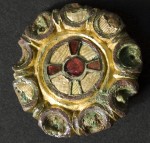An extensive archaeological survey of a farmstead on the Danish island of Zealand slated for residential development uncovered traces of a Late Iron Age/Viking Age settlement and several pieces of important metal jewelry from that era. Between April and December of 2007, experts from Roskilde Museum excavated a total of approximately 27,000 square meters (290,000 square feet) on the 15 hectare Vestervang farm. They found the remains of 18 longhouses and 21 pit houses of modest size — none were more than 65 feet long — which weren’t all constructed at the same time. This wasn’t a town but rather a single farm built up over time in six phases between the late seventh century and the early 11th.
The jewelry unearthed on the site of this farm is far more luxurious than you might expect to find at a modest farm size. There are gilded pieces, intricately carved pendants and brooches, probably imports like a trefoil brooch from 850-950 A.D. designed in a Carolingian style and a pre-Viking brooch with a gold accents in a waffle texture and Christian cross motif in red glass that reminds me of some of the Staffordshire Hoard pieces.
 The star of the show is a copper alloy piece 2.9 inches in diameter with a central animal figure wearing a beaded chain around its neck. Three masked figures with moustaches are placed around the object, one on either side of the main character, one across from it. Four holes between the masked men suggest there was additional decoration, perhaps two more animal figures like the central one. Experts believe it may have been part of a necklace.
The star of the show is a copper alloy piece 2.9 inches in diameter with a central animal figure wearing a beaded chain around its neck. Three masked figures with moustaches are placed around the object, one on either side of the main character, one across from it. Four holes between the masked men suggest there was additional decoration, perhaps two more animal figures like the central one. Experts believe it may have been part of a necklace. According to the archaeologist Ole Thirup Kastholm, author of a paper on the excavation published in the latest issue of the Danish Journal of Archaeology, this is a rare piece and would have been extremely high-end in Viking times.
He said that the animal image itself seems to be anthropomorphic, something not unusual in Viking age art. “Some of these anthropomorphic pictures, though, might be seen as representations of ‘shamanic’ actions, i.e. as mediators between the ‘real’ world and the ‘other’ world,” Kastholm wrote in an email to LiveScience. He can’t say for sure who would have worn it, but it “certainly (was) a person with connections to the elite milieu of the Viking age.”
 The Christian cross also must have adorned a person of rank. Made between 500 and 750 A.D., it’s not the product of local artisans. It was in all likelihood manufactured in continental Europe and decades or centuries later made its way to Southern Scandinavia, either through trade networks or perhaps carried by a Christian visitor.
The Christian cross also must have adorned a person of rank. Made between 500 and 750 A.D., it’s not the product of local artisans. It was in all likelihood manufactured in continental Europe and decades or centuries later made its way to Southern Scandinavia, either through trade networks or perhaps carried by a Christian visitor. What would make this tidy but seemingly unremarkable farm a magnet for such expensive, rare jewelry? Kastholm thinks the key is the farm’s proximity to Lejre, a site just six miles away which according to Beowulf and the Saga of King Hrolf Kraki was the royal seat of the legendary first ruling Danish dynasty the Skjöldung or Scylding clan.
In the 1960s, there was vast residential development in the area of Vestervang, but maps that predate the development show two villages near the site with “Karleby” in their name, something that may signify that the area was given to retainers of Lejre’s ruler.
“The old Scandinavian term karl, corresponding with the old English ceorl, refers to a member of the king’s professional warrior escort, the hirð,” Kastholm writes in the journal article.
Together, the rich jewelry finds at Vestervang, the site’s proximity to Lejre and the presence of two nearby villages with the names “Karleby” reveal what life may have been like at Vestervang.
It “seems probable that the settlement of Vestervang was a farm controlled by a Lejre superior and given to generations of retainers, i.e. to a karl of the hirð,” Kastholm writes. “This would explain the extraordinary character of the stray finds contrasting with the somewhat ordinary traces of settlement.”











































